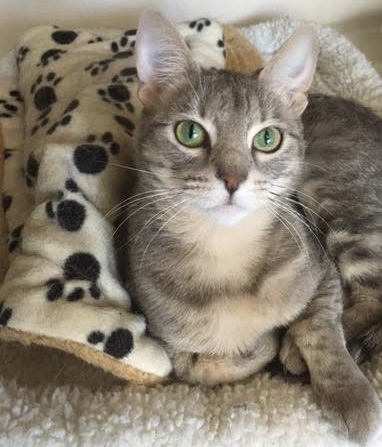
22 Jun Second Chance: Plague in Modern Times
Back in the 1300’s, bubonic plague killed 25 million people in Asia and Europe. No one knew back them that the virulent bacteria was carried by fleas, which in turn were carried by rodents. In fact, superstition led some in the Middle Ages to blame the whole shebang on “evil cats,” which resulted in wholesale slaughter of felines. Which in turn, just led to the increase of rodents – which carried the fleas which carried the plague. Which goes to show that blaming the cat is never the answer. The plague scoured Europe until the 1600s.

Lefty, who is plague free and full of life and love.
Jump forward 500 years and guess what – we still have Plague. The big difference is that today we also have antibiotics. So if people get “Plague” we can treat them. Animals too. But you can’t treat what you don’t recognize. So it’s a good idea to get informed about Plague and what to look for. Especially since it was just diagnosed in a cat in Delta County.
So unfortunately this was the exact same kind of plague they had in the Middle Ages: the Bubonic type. The most identifiable symptom in an infected animal is the lymph nodes get big and tender, but the plague can also present as a respiratory infection, or as septicemia (blood born infection.)
So, here’s what you should know.
Plague is caused by Yersinia Pestes, which is a bacteria. It is transmitted by fleas, by handling tissues of infected animals (say, a dead rabbit or rodent) or by contacting airborne droplets from an infected animal or human. Dogs are highly resistant to Plague; cats are not. And nearly 60% of all cats infected eventually die of the disease.
Additional symptoms you should look for in cats are as follows: lethargy, high fever, refusal to eat, vomiting, diarrhea, enlarged lymph nodes, and mouth sores. In humans, the case will present within 2-6 days after exposure as headache, fever, chills and weakness. Enlarged lymph nodes may or may not develop, and the illness can cause shock, multiple organ failure, and death.
To prevent Plague: stay away from fleas, don’t let your animals chase and kill rodents or rabbits. If you have a prairie dog colony near your home pay attention. If the animals are active, then they don’t have plague. If you notice that the whole colony suddenly looks like a ghost town, call your county health department and report it. They will test for plague.
And now, our shelter dog and cat of the week – who definitely do not have plague!!!
Lefty is a wonderful female border collie mix, around a year or two young. She decidedshe did not want to live the life of her forefathers as a working dog and that cows are scary when they are running toward you. So she is looking for her chance to live the life of a non-working dog. Lefty feels she is more suited for snuggling, hiking, and playing and is seeking employment as the family dog rather than scurrying from large hooves.

Twiggy is a beautiful young grey tabby female, around a year old. She has no interest in working but rather to let her charming, loving, playful personality to just organically win her a place in your home. She does well with other cats and believes that life is best lived in the company of a being that purrs
Editor’s note: It’s no secret. The Telluride region is dog heaven. Well, pet heaven. Unless you are one of our furry friends who gets caught in the maw of neglect and abuse. Then heaven is on hold until Second Chance Humane Society comes to the rescue. Second Chance is the region’s nonprofit dedicated to saving animals’ lives and promoting responsible pet parenting and human-animal bond. In her weekly blog, executive director Kelly Goodin profiles at least one, generally two of the many animals now living at the no-kill shelter, Angel Ridge Shelter, a dog and a cat, hoping to find them loving permanent homes. The column is sponsored by Ted Hoff of Cottonwood Ranch & Kennel, who from time to time exercises his skills as a dog whisperer, partnering with Kelly and her staff to help train a particularly challenging animal.
By the by, there is no better place to park your pup or get your pup (or adult dog) trained than Cottonwood whenever you head out of town (for locals) or are heading to town and staying somewhere that does not allow pets. Consider joining Ted’s Very Important Dog (VID) Club for added benies. (Details on Ted’s website.)
Second Chance Humane Society Animal Resource Center and Thrift Shop are both located in Ridgway, but service San Miguel, Ouray & Montrose Counties. Call the SCHS Helpline at 626-2273 to report a lost pet, learn about adopting a homeless pet, or about the SCHS Spay/Neuter, Volunteer, Feral Cat, or other Programs. View the shelter pets and services online: www.adoptmountainpets.org
Vetting the Vet: Dr. Michelle Dally. DVM, J.D. is Medical Director of Second Chance Humane Society. She also has a private practice, Dally Veterinary Medicine, 333 S. Elizabeth Street, Ridgway, Colorado. But Dr. Michelle makes house calls. (Yes, in Telluride.) Call 970-318-0897. For more on Dr. Dally, go here.




Sorry, the comment form is closed at this time.